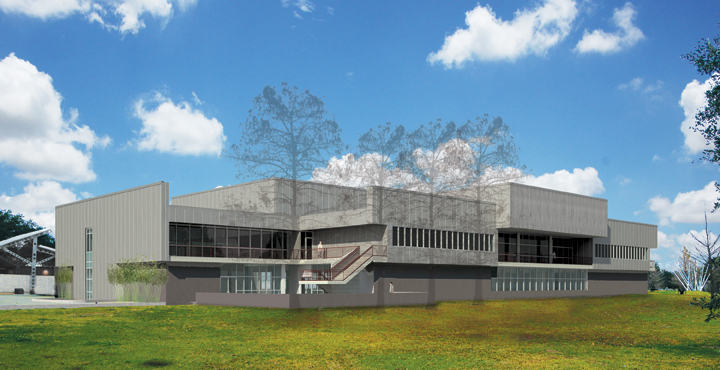Ziler Architects of Lafayette released today an approved rendering of upcoming renovations for Joel L. Fletcher Hall on the University of Louisiana at Lafayette campus.
“The rendering offers perspective of improvements proposed to correct extensive leaks and of the design that will provide an additional 20,000 square feet of educational space on the second floor,” said Jim Ziler, the project architect.
For three years, the university has been planning renovations to Fletcher Hall while attempting to secure additional funding to remediate waterproofing deficiencies that have existed since the building was constructed in the 1970s. The building houses the School of Architecture and Design and the Department of Visual Arts.
The design modifies Fletcher Hall with reconfigured roof profiles, along with changes to the building’s concrete skin. The existing interior atrium will remain open at the top; glass walls will enclose the balconies of all three floors.
Hector LaSala, one of the UL Lafayette architecture professors who assisted during the final design process, said the new exterior materials and details integrate second-floor additions while preserving, even improving, the building’s overall aesthetic continuity.
“A key decision was to forgo adding traditional red brick to the first-floor exterior, among early design options,” LaSala said.
“The aggregate will remain on the first-floor exterior walls; it will be repaired, cleaned, weatherproofed and coated to complement the metallic color of new metal panels planned for the upper floors. A slight vertical corrugation of the panels will add a shadow play to the walls.”
Ziler said the panels are energy efficient and cost effective. He said that parapets of the same material will be added, extending the vertical profile of exterior walls on the second-floor additions to prevent the pitched roofs from dominating the configurations. The added roofs will have a slight slope to direct rain away from the walls.
Students and community members had expressed dissatisfaction with early designs posted on Ziler’s website, and proposed additions based on preliminary models, that were intended solely as studies. In early December 2012, messages to the university, a Facebook group and an online petition conveyed their opinions.
The initial study models that had circulated did not represent the final design, materials or colors, Ziler said.
At a Dec. 20 meeting, the state’s Office of Facility Planning and Control concurred with the project architect that a sprinkler and fire-alarm system would be a necessary addition to the project, according to Bill Crist, director of the university’s Facilities Management. At that meeting, he notified the state office that the architect and the university were reviewing designs to develop a final rendering.
The university allocated $500,000 in additional funding for the sprinkler and fire-alarm system, according to Crist.
“Refinements to the final design occurred through cooperative efforts,” said Gordon Brooks, dean of the College of the Arts. “The project expanded beyond its primary role to remediate water damage and improve safety. Design also was a significant focus.”
Final Design Process
On Dec. 28, a six-person group met on campus to deliberate conceptual design options for Fletcher Hall: Branden Leger and Brant Patout, students majoring in architecture; Kerrie Butts and John Maak, architecture graduates from UL Lafayette; and Geoff Gjertson and Hector LaSala, members of the school’s faculty.
UL Lafayette alumnus Charles Beazley, a local architect, also was instrumental in critiquing the project, according to Ziler.
Ziler said that his firm, with the input from faculty members, alumni and students, worked last week to complete the final rendering.
“Jim reviewed cost and structural modifications, and consulted with his engineer, while we made adjustments,” LaSala said. “From then on, Ziler and his staff pushed the design to a final solution.
“The design not only repairs the existing problems, it ultimately makes Fletcher Hall an outstanding building.”
Brooks said: “Jim Ziler deserves credit for being so receptive to input. The university administration and the state facility planning office have been supportive. And, we are especially grateful to our architecture students, alumni and faculty who contributed time and effort to the process.”
LaSala said the process was “exemplary of true collaboration. We concluded with a design that reflects the prestige of our programs.”
Next Steps
Construction is expected to begin in April, according to Crist.
“We need to get a construction bid within the allocated $4 million budget,” said Ziler. “Budget and ultimate costs are still major concerns for completion of the project.”
Crist said another phase of the renovation – for interior buildouts of the second-floor additions and mechanical systems replacement – will occur once more funding is secured.
